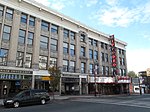Laurel Hall
Apartment buildings in Springfield, MassachusettsApartment buildings on the National Register of Historic Places in MassachusettsBuildings and structures completed in 1914National Register of Historic Places in Springfield, Massachusetts

Laurel Hall is a historic apartment house at 72—74 Patton Street in Springfield, Massachusetts, USA. Built in 1914, it is one of a small number of apartment houses built on the north side of the city's downtown area in the 1910s and 1920s. The building underwent a major rehabilitation and renovation in the 1980s. It was listed on the National Register of Historic Places in 1987.
Excerpt from the Wikipedia article Laurel Hall (License: CC BY-SA 3.0, Authors, Images).Laurel Hall
Patton Street, Springfield
Geographical coordinates (GPS) Address Nearby Places Show on map
Geographical coordinates (GPS)
| Latitude | Longitude |
|---|---|
| N 42.11 ° | E -72.599166666667 ° |
Address
Patton Street 52;54
01107 Springfield
Massachusetts, United States
Open on Google Maps










